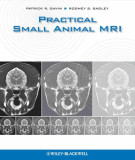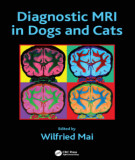
Abdominal MRI
-
Ebook Computed body tomography with MRI correlation (Fourth edition): Part 1 includes content: Magnetic resonance imaging principles and applications, interventional computed tomography, interventional computed tomography; heart and pericardium,… and other contents.
 844p
844p  longtimenosee03
longtimenosee03
 01-02-2024
01-02-2024
 0
0
 0
0
 Download
Download
-
Ebook Computed body tomography with MRI correlation (Fourth edition): Part 2 includes content: The biliary tract, the pancreas, abdominal wall and peritoneal cavity, the adrenal glands, musculoskeletal system, pediatric applications,… and other contents.
 994p
994p  longtimenosee03
longtimenosee03
 01-02-2024
01-02-2024
 5
5
 0
0
 Download
Download
-
Part 2 book "Practical small animal MRI" includes content: Orthopedic, magnetic resonance imaging of abdominal disease, thorax, head - Non - CNS, cancer imaging.
 129p
129p  muasambanhan03
muasambanhan03
 02-01-2024
02-01-2024
 2
2
 2
2
 Download
Download
-
Part 2 book "Diagnostic MRI in dogs and cats" includes content: Normal MRI spinal anatomy, degenerative disc disease, and disc herniation, cervical spondylomyelopathy, MRI of musculoskeletal , MRI of the thorax and abdomen, abdominal MRI.
 356p
356p  oursky08
oursky08
 01-11-2023
01-11-2023
 4
4
 2
2
 Download
Download
-
Abdominal computed tomography (CT) is the standard imaging method for patients with suspected colorectal liver metastases (CRLM) in the diagnostic workup for surgery or thermal ablation. Diffusion-weighted and gadoxetic-acid-enhanced magnetic resonance imaging (MRI) of the liver is increasingly used to improve the detection rate and characterization of liver lesions.
 10p
10p  vimahuateng
vimahuateng
 26-11-2021
26-11-2021
 7
7
 0
0
 Download
Download
-
To describe the Gd-EOB-DTPA-enhanced MRI appearances of cholangiocarcinoma, and evaluate the relative signal intensities (RSIs) changes of major abdominal organs, and investigate the effect of total bilirubin (TB) levels on the RSI.
 9p
9p  vialabama2711
vialabama2711
 21-09-2020
21-09-2020
 13
13
 1
1
 Download
Download
-
(BQ) The document delivers detailed imaging of all areas of the abdomen and pelvis—including the liver and biliary system, pancreas, GI tract, spleen, mesentery/omentum/peritoneum, kidney and urinary system, retroperitoneum and adrenal glands, and abdominal wall—helps readers understand relevant anatomy and identify pathologies.
 115p
115p  thangnamvoiva5
thangnamvoiva5
 14-07-2016
14-07-2016
 49
49
 5
5
 Download
Download
-
This book, like its conventional counterpart Normal Findings in Radiography, deals with the apparently banal subject of the normal. It addresses the question of how to recognize what is normal and how to describe normal findings. These questions are as important in computed tomography and magnetic resonance imaging as in other modalities. Even “sectional imaging” is based on the classical approach of reading images and formulating findingPetrous pyramids
 257p
257p  waduroi
waduroi
 03-11-2012
03-11-2012
 89
89
 11
11
 Download
Download
-
Raja et al. International Journal of Emergency Medicine 2011, 4:19 http://www.intjem.com/content/4/1/19 ORIGINAL RESEARCH Open Access Abdominal imaging utilization in the emergency department: trends over two decades Ali S Raja1,2,4*, Koenraad J Mortele1,3,4, Richard Hanson1,3, Aaron D Sodickson1,3,4, Richard Zane1,2,4 and Ramin Khorasani1,3,4 Abstract Background: To assess patterns of use of abdominal imaging in the emergency department (ED) from 1990 to 2009.
 6p
6p  dauphong13
dauphong13
 09-02-2012
09-02-2012
 81
81
 8
8
 Download
Download
-
Clinical Presentation The presenting signs and symptoms include hematuria, abdominal pain, and a flank or abdominal mass. This classic triad occurs in 10–20% of patients. Other symptoms are fever, weight loss, anemia, and a varicocele (Table 90-4). The tumor can also be found incidentally on a radiograph. Widespread use of radiologic cross-sectional imaging procedures (CT, ultrasound, MRI) contributes to earlier detection, including incidental renal masses detected during evaluation for other medical conditions.
 5p
5p  konheokonmummim
konheokonmummim
 03-12-2010
03-12-2010
 59
59
 2
2
 Download
Download
-
Carcinoma of the Ampulla of Vater This tumor arises within 2 cm of the distal end of the common bile duct, and is mainly (90%) an adenocarcinoma. Locoregional lymph nodes are commonly involved (50%), and the liver is the most frequent site for metastases. The commonest clinical presentation is jaundice, and many patients also have pruritus, weight loss, and epigastric pain. Initial evaluation is performed with an abdominal ultrasound to assess vascular involvement, biliary dilatation, and liver lesions. This is followed by a CT scan, or MRI and especially MRCP.
 6p
6p  konheokonmummim
konheokonmummim
 03-12-2010
03-12-2010
 68
68
 4
4
 Download
Download
CHỦ ĐỀ BẠN MUỐN TÌM
























